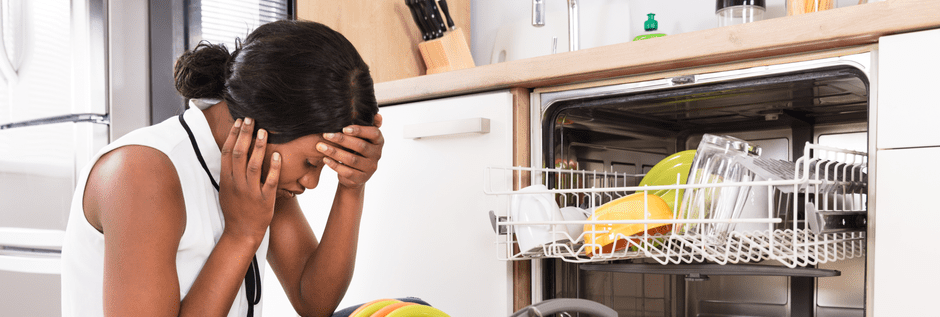What to do if your dishwasher is not draining
Here’s how to DIY and save yourself a chunk of change

Key tips to remember
- Disconnect power before troubleshooting
- Check, remove and clean the filter
- Clean the disposal, if you have one
- Check the drain hose for kinks, corrosion or blockages
- Always rinse your dishes first — you’ll thank yourself later
Fixing a dishwasher that won’t drain is often a simple troubleshooting process, and you don’t have to be an expert or even all that handy with a wrench. If you’re trying to save money, you probably want to avoid calling a dishwasher-repair service technician for in-home service because it could end up costing you an arm and a leg. If your dishwasher won’t drain completely, there’s good news. It’s likely something you can fix yourself. Knowing how to fix standing water in dishwasher tubs can be as easy as following a few tried-and-true suggestions. Before you start searching online for things like “how do I remove standing water from a dishwasher,” check out our handy list of DIY checks and fixes that could save you a little time and a lot of money.
Standing water
If you’ve noticed any leftover water in your dishwasher after running a cleaning cycle, there are several potential causes, particularly clogs in your filter, drain hose, drain pump, air gap or disposal. Sometimes running another cycle again will solve the problem. If not, whether the cause is mineral buildup from hard water, food particles or some combination of both, chances are good that you can find the blockage and clear it out yourself. Clogs are best avoided by rinsing dishes before loading them, so keep that in mind for the future.
If there’s no clog, you might have waited too long to do a little maintenance, which we’ll discuss, and there might be parts to replace. Or you could have used the wrong type of soap or overloaded it. Fear not, you may well be able to fix whatever it is. Put out some towels and grab a bucket. Then disconnect power to the unit, bail out the leftover water, and do some checks.
Plumbing check
The drain pump, drain hose, drain solenoid and hose clamp work together to make sure your drain valve functions well. Inspect each for signs of wear and consider replacement when in doubt. Most plumbing-related issues contribute to a dishwasher not draining center on the drain hose, which connects the drain pump to either a garbage disposal or air gap (more on this later) and flushes dirty water away from the dishwasher. Check to make sure this essential hose is connected properly and there are no visible clogs or kinks in the line. If you see or suspect one, disconnect the hose and try blowing through the line or pushing a wire hanger through it. If it’s not already situated in what’s called a “high loop” orientation, reorient the hose so that the top of its loop is at least 30 inches above the floor, which will add some gravity to help clear the drain when it’s in use going forward.
Disposal check
If you don’t have a disposal, your dishwasher has its own drainage pipe, but most connect to disposals for drainage. If you’ve tried running the disposal for a minute or so and still have water backed up, remember that your dishwasher is most likely connected to your disposal for drainage, which attaches to an outside drain pipe. If your disposal seems clogged, try a drain cleaner. Chase the drain cleaner with hot water, and then try running the dishwasher.
If you still have standing water after the cycle, you need to deep-clean your disposal. Cut power to the unit, look inside with a flashlight, remove any obstructions with tools (not fingers), and then restore power. To clean the blades, run the disposal with two cups of ice and a half-cup of kosher salt for a minute or two. Chase this with a half-cup of baking soda and a cup of vinegar. Take a break for 20 minutes or so to let these natural cleaners do their magic. When you return, get in there with a toothbrush to clean any remaining residue from the inside. Next, run hot water through the disposal (while powered on) and let it drain. If the problem was a disposal clog, it should be all fixed up by now. Run a citrus peel or two through the disposal to add a fresh, natural scent.
Air gap cylinder check
Another part that might cause your dishwasher not to drain is an air gap cylinder. Not all dishwashers have them, but an air gap (or air cap) cylinder keeps wastewater from entering the dishwasher. In some states, this feature is a code requirement, but others don’t mention it at all. Designed to keep water flowing in the right direction and prevent used water from sticking around when no longer needed, the air gap cylinder can usually be found near the dishwasher’s drain hose behind the sink. Make sure that it’s not clogged or dirty. Flush it out with clean water and a little baking soda if necessary, and secure tightly before moving on.
Filter check
Another reason your dishwasher might not drain is a clogged filter, which is why filters should be cleaned regularly. If you can find your dishwasher manual, you’re in luck because it will have a section on the filter, its location, and when and how to change it. If you don’t have the manual, it’s often easy to find online, provided you have the brand name and model number.
Usually located inside the tub and near its lowest point, every dishwasher has a filter of some sort designed to capture any loose bits of food or other stray particles that could soil the water or clog the machine. Some are labeled “self-cleaning” but might still need a little help to get there. You may need a screwdriver to remove the filter, though some snap in and out without tools. Some filters have a separate basket of sorts that allows room for these particles to accumulate, preventing them from recycling through the system during washes. After cutting power to the unit and locating the filter, remove it, clean it in the sink with soapy water and a toothbrush, then rinse and replace it. If you see anything else dirty near the drain or filter, clean it, too.
Spray arm check
If you’re still having trouble pinpointing the cause of a dishwasher that won’t drain, there’s a small chance that you could have a clogged spray arm. The spray arms are the long propeller-blade-looking parts that spin around the bottom of your dishwasher’s tub. They have tiny little holes that spray water everywhere, and they can become clogged with food particles on rare occasions, causing water to collect in the bottom of the tub. Toothpicks, paperclips or wires are good tools to clear out clogged holes in spray arms, but be sure to turn off the power before you start the process. Some spray arms are removable, so you can soak the whole arm in a vinegar solution before making sure all holes are clear.
Drain check (clean and flush)
If you’re still stumped on the cause of the standing water in your dishwasher, you can try clearing the drain from inside after scooping and dumping the leftover water. Mix a 50/50 baking soda and vinegar solution and pour it into the drain at the bottom of the tub, letting it sit for about 20 minutes before chasing it with a bucket of hot water. Next, try running the dishwasher on the rinse cycle, and hopefully whatever is causing the blockage will rinse away.
Clog prevention
If none of these methods work, and you still have standing water after running a load of dishes, it may be time to go ahead and call a professional for help, or at least your buddy who knows a thing or two about dishwashers. In terms of thinking ahead to prevent this from happening again, we have a few suggestions:
- Make sure you rinse your dishes before you put them in the dishwasher. That’s the single most important step to prevent future headaches. It’s simple: If you don’t have leftover food flying around when the dishes are being washed, it won’t be there to get stuck in nooks and crannies and create clogs.
- Read your manual. It’s full of good suggestions for optimizing your dishwasher’s performance.
- Clean your filter regularly, and use the right dish soap. If you hear any weird sounds during a cycle, call a pro for diagnostic help.
Thanks for reading our post on what to do when you find yourself with a dishwasher not draining. While you’re here, you may also want to review some of our additional posts on related topics, like whether a home warranty covers the dishwasher, how to clean and maintain a dishwasher, how to troubleshoot a dishwasher and how to get the most out of your dishwasher. Posts on these and many other DIY home improvement and maintenance topics await you on our blog, so stick around!
The information in this article is intended to provide guidance on the proper maintenance and care of systems and appliances in the home. Not all of the topics mentioned are covered by our home warranty or maintenance plans. Please review your home warranty contract carefully to understand your coverage.
